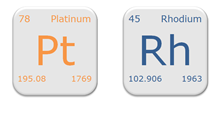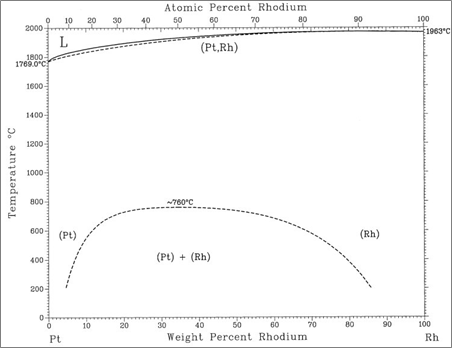 The platinum materials used in the largest quantities – in particular for applications at high temperatures – are the alloys of platinum with rhodium, and the most commonly used alloys have rhodium contents of 10 or 20%. Compositions with up to 30% rhodium are also used.
The platinum materials used in the largest quantities – in particular for applications at high temperatures – are the alloys of platinum with rhodium, and the most commonly used alloys have rhodium contents of 10 or 20%. Compositions with up to 30% rhodium are also used.
The phase diagram of the platinum-rhodium alloy system shows a continuous solid solution with no tendency to phase separation above approx. 760°C. Because of the relatively low temperature of the phase separation, it does not normally arise under practical conditions.
Whereas platinum has a Young’s modulus of 165 GPa, the Young’s modulus of rhodium is 372 GPa[i]. As one would expect on the basis of these values, platinum-rhodium alloys have substantially higher mechanical strength at all temperatures than chemically pure platinum. Even at temperatures immediately below the melting temperature, the platinum-rhodium alloys demonstrate oxidation resistance that is similar to that of platinum.

[i] Jürgen Merker, David Lupton, W.C. Heraeus GmbH & Co. KG and Michael Töpfer, Harald Knake, Friedrich Schiller Universität, Jena, „High Temperature Mechanical Properties of the Platinum Group Metals“, Platinum Metals Review, Vol. 45, 2001, pp. 74-82